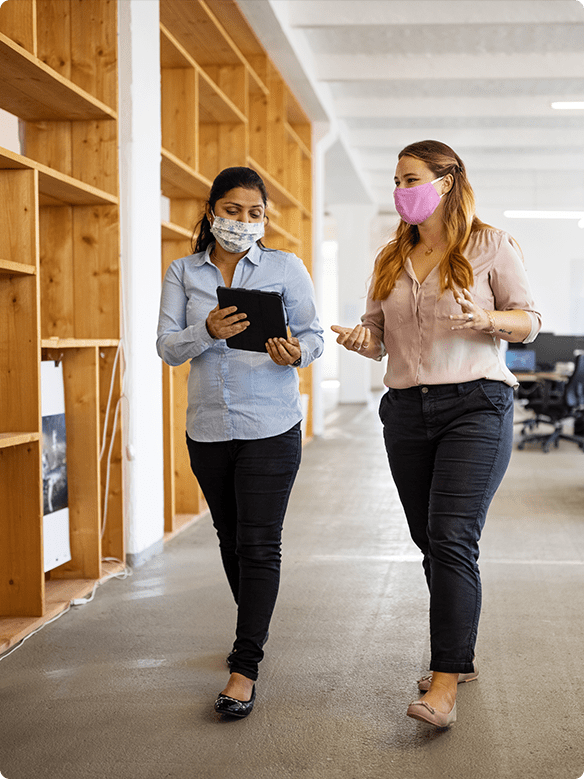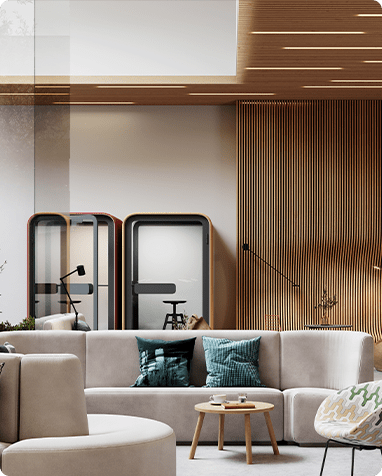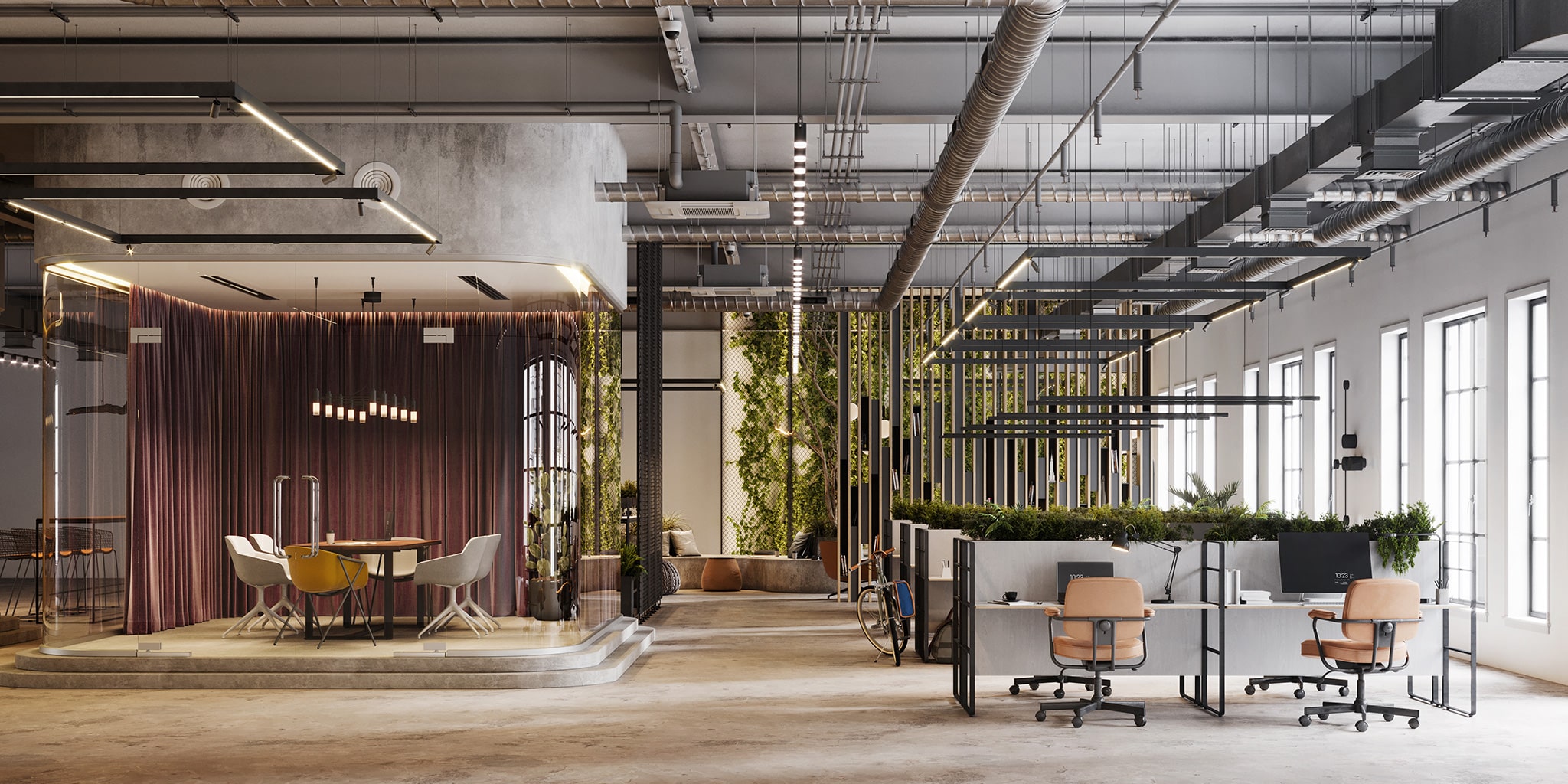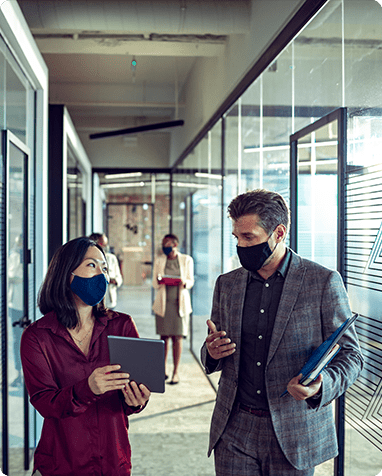Built for Purpose, Designed to Thrive
The office of the future will blend design and technology in ways that nurture new ideas in an environment that enhances safety and well-being.
The coronavirus crisis is redefining the concept of the office. Far from giving up on people collaborating, co-creating, and inspiring each other under the same roof ever again, companies are rethinking office designs for the post-pandemic world.
Working virtually is here to stay. But, instead of replacing the modern office, it will become integral to a hybrid way of operating that combines the benefits of working in groups with the safety, flexibility, and advantages of working remotely. In short, the office of the future will bring us together while keeping us safely distanced.
It’s tempting for companies to conclude the office is irrelevant. But not so fast. The office simply cannot go away.
“It is necessary on multiple levels—for our effectiveness, for our sanity, and for our humanity,” Tracy Brower, a work environment sociologist, once wrote.
An office is more than just a place of work. At its best, the office can engender a sense of social well-being, provide an environment where new ideas abound and creativity flourishes, serve as an anchor to company culture, and a beacon that attracts new talent. While people’s expectations of the workplace have changed after more than a year of working from home, they wonder how much the office itself will have changed and how different will it be when they return in the not-too-distant future.

1 January 2020
It begins as a year like any other.
Then...
25 April 2020
76% of the 185 countries or regions surveyed either mandate
strict or partial physical workplace closure, or recommend it.
25 April 2021
Between 1 January 2020 and 25 April 2021, more than 150 countries or regions have spent at least half of the time under a strict, partial, or recommended workplace closure.
The hybrid workplace is here to stay.
Post-pandemic
Office Design
Architects have been busy reimagining everything from office layouts to hi-tech workspaces set in an eco-friendly environment that enhances workers’ safety and well-being. Business leaders, on their part, will need to rethink work culture to fulfill employees’ changing expectations of balancing work and life.
The post-pandemic office will see larger open-plan layouts, smaller conference areas, and more intensive use of technology to enhance collaboration among people seated at workstations organized in pods.


New York-based Schrimmer Design Group and Toronto-based Lebel & Bouliane are architectural design firms that have proposed desk pod concepts that allow teams of three to four people to work in close collaboration while remaining safely distanced.
The two companies, which began working on new types of workstations and work pods even before the pandemic, believe their designs are ideally suited to foster creativity and collaboration safely. Working in pods of three to four will “allow for working closely without the need for temporary plastic shields,” which can be a barrier to effective teamwork, they say.

The X and Y prototype desks propose a permanent solution for working together (but separately) as office environments evolve.
The pods and workstations conceived by Schrimmer and Lebel & Bouliane would be equipped with technological add-ons such as central screen displays for meetings, thereby enhancing safety while nurturing a productive office setting.
Large meeting spaces may soon be a thing of the past. Conference rooms with boardroom tables capable of seating ten or more persons are no longer optimal from a health safety standpoint. The post-pandemic office will, therefore, favor smaller conference rooms with built-in collaboration technology to prevent crowding.
While offices may still need areas to facilitate safe interaction with visitors and external partners, the new pod designs could potentially eliminate the need for conference rooms since the pods themselves would double up as meeting spaces. By incorporating audiovisual conferencing technology into each pod, workers will be able to multitask, effectively extending useable real estate.

Cleaner and Greener
Workplaces
The role of technology will not be limited to fostering collaboration and bolstering productivity.
Since the pandemic began, proper ventilation has become paramount. Efficient heating and cooling systems are essential for stopping the spread of viruses and other airborne pathogens. The future-ready office will incorporate not only advanced filtration systems but also those connected to the Internet of Things and other sensors to conserve energy. New office designs also envisage using facial recognition to control doors and smartphones to operate elevators and audiovisual systems.
Besides using green technology, the post-pandemic office will also see more green spaces. According to Schrimmer and Lebel & Bouliane, the trend toward “healthier and greener interior spaces” that began before the pandemic is set to continue, with landscaping consultants adding “plants and green walls” to incorporate nature into offices.


Leadership in the
New Normal
However, office redesign is not an end in itself and needs to be part of a more fundamental change in work culture. Businesses will need to pivot, embracing leadership structures and styles that give employees a sense of professional fulfillment and work-life balance so that they look forward to coming into the office more often.
A hybrid work environment would enable workers to collaborate virtually part of the time, then return to the office to connect with colleagues. Working in pods that might include people from different departments with diverse expertise encourages collaboration and enable solving complex and abstract problems in ways that cannot be replicated while in isolation.
Recent studies have concluded that most workers prefer hybrid work policies, and many companies are already catching on. According to the Accenture Future of Work Study 2021:
work model
adopting a “productivity anywhere”
workforce model


A flexible work environment will be crucial to making workers future-ready and enabling them to thrive. The office of the future will house a workforce that is truly agile and flexible and assured of its safety.
Future work arrangements will need to be bolstered by smart leadership styles capable of unlocking the creativity and enhancing the productivity of individuals working in teams that might never be under the same roof at the same time.
The unprecedented speed and scale of adoption of digital technology and new social norms since the onset of the pandemic has changed society irreversibly and has done so in positive ways. As governments ease restrictions on the movement and assembly of people, the success of companies will be determined by their ability to create offices that blend technology, design, health, and well-being of workers.
The Shape of
Things to Come
As recovery plans kick into overdrive, human ingenuity and technology will drive insights into action and help change how the world works and lives for the better.
Learn more

